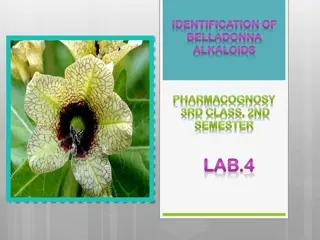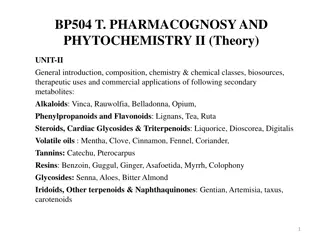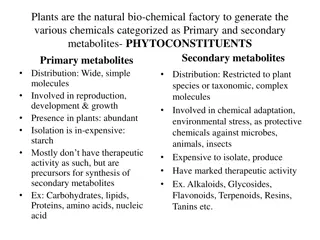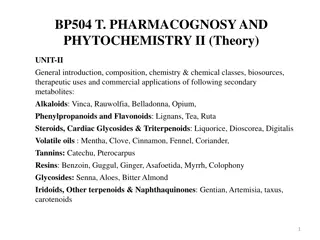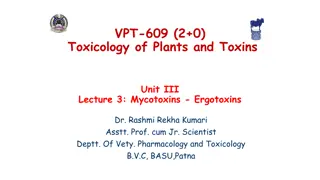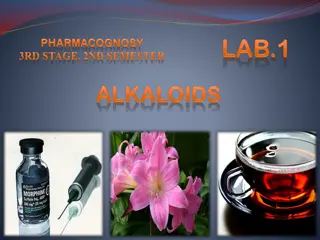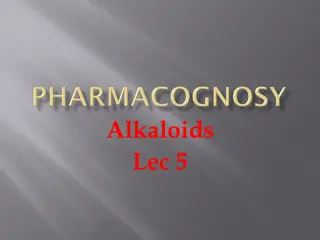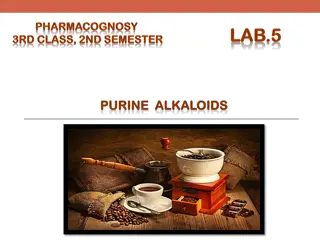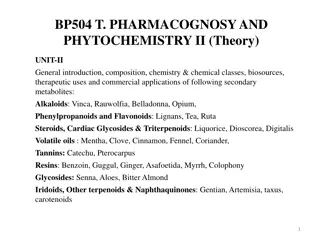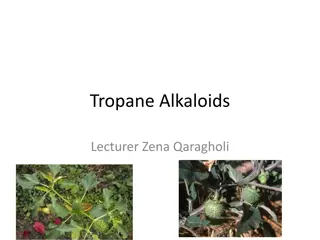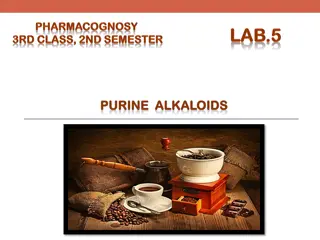Understanding Alkaloids: Sources, Names, and Classification
Alkaloids, organic nitrogenous compounds of plant origin, are physiologically active and can contain elements like carbon, hydrogen, nitrogen, oxygen, sulfur, and more. They are found in various plant families such as Leguminosae, Papaveraceae, and Solanaceae. Alkaloids can be sourced from plants, animals, bacteria, fungi, and even industrially synthesized. Their names are derived in different ways, and they are classified into true, proto, and pseudo alkaloids based on their structure. Alkaloids are further categorized into non-heterocyclic and heterocyclic types based on their chemical structure, with various subgroups like pyrrol, pyridine, and indole alkaloids.
Download Presentation

Please find below an Image/Link to download the presentation.
The content on the website is provided AS IS for your information and personal use only. It may not be sold, licensed, or shared on other websites without obtaining consent from the author. Download presentation by click this link. If you encounter any issues during the download, it is possible that the publisher has removed the file from their server.
E N D
Presentation Transcript
Introduction Introduction Are defined as organic nitrogenous compounds of plant origin that are physiologically active. In addition to carbon, hydrogen and nitrogen, alkaloids may also contain oxygen, sulfur and more rarely other elements such as chlorine, bromine, and phosphorus. The following families represent good examples:- Leguminosae Papaveraceae Ranunculaceae Rubiaceae Solanaceae Berberidaceae
Sources of Alkaloids Sources of Alkaloids Natural sources Natural sources a) Plants (ephedrine) Ephedra sinica b) Animal (bufotenin) from skin c) Bacteria d) Fungi (psilocybin) from Psilocybe Industrial sources Industrial sources Nicotinic acid can be synthesized from tryptophan or aspartic acid.
The names of alkaloids are obtained in various The names of alkaloids are obtained in various ways: ways:- - 1) From the generic name of the plant as atropine Atropa belladonna 2) From the specific name of the plant as cocaine Erythroxylum coca. 3) From the common name of the drug ergotamine(ergot) . 4) From their physiologic activity as emetine producing emesis. 5) From the discoverer as pelletrine. 6) Other e.g. morphine derived from ancient Greek mythology Morpheus god of dreams
Classification Classification True alkaloids characterized by a heterocyclic ring with a nitrogen atom, and are derived from amino acids for example: are atropine, nicotine, and morphine. Proto alkaloids characterized by absence of the heterocyclic ring but also derived from amino acids for example: adrenaline and ephedrine . Pseudo alkaloids characterized by a heterocyclic ring with a nitrogen atom, but are not derived from amino acids.
In general the alkaloids are classified according to the chemical structure in two broad divisions:- A) Non-heterocyclic or atypical alkaloids or biological amines. B) Heterocyclic or typical alkaloids, divided into (14) group according to their structure, as the following:-
1) Pyrrol and Pyrrolidine. 2) Pyrrolizidine. 3) Pyridine and Piperidine. 4) Tropane. 5) Quinoline. 6) Isoquinoline. 7) Aporphine 8) Norlupinane. 9) Indole. 10) Indolizidine. 11) Imidazole. 12) Purine. 13) Steroid. 14) Terpenoid
Alkaloid Description Contains nitrogen - usually derived from an amino acid Bitter taste. Usually colorless Some alkaloids are colored, yellow or orange. Generally solids (except - nicotine is a brown liquid). They give a precipitate with heavy metal iodides, except Caffeine.
Most alkaloids are weak bases, but some are amphoteric, for example theobromine and theophyllin. Most alkaloids are poorly soluble in water but its dissolve in organic solvents, such as diethyl ether, chloroform. However, caffeine dissolves well in boiling water Toxic ex cyclopamine which is present in the leaves of corn lily.
Chemistry of Alkaloids Alkaloids usually contain one nitrogen atom, but some may contain up to (5) the nitrogen may exist as a primary amine (RNH2), as a secondary amine(R2NH), or as tertiary amine (R3N) .
Applications In medicine
Black pepper Black pepper Botanical name Piper Family name Piperaceae Piper nigrum nigrum Piperaceae
It belongs to the third group of the typical alkaloids, which is the pyridine and piperidine group. This plant is a perennial plant producing berry-like and aromatic pungent fruits, that are green when unripe and become red at mature, then the dried berries become black and wrinkled producing black pepper. The pepper yields both, black and white pepper according to the method of drying. In that when the ripe and the unripe fruit are dried directly under the sun, black pepper is the result. While if the fruit is soaked, and then removed the outer skin, before drying and then the result is white pepper.
Cont The alkaloid extracted from the black pepper is piperine. Piperine alkaloid is a solid substance essentially insoluble in water. It is a weak base that is tasteless at first, but leaves a burning after taste. The molecular formula is C17H19O3.
The Pharmacological Activity of Piperine The Pharmacological Activity of Piperine 1) Piperine aid in the digestion of food due to its stimulation to the digestive enzymes. 2) There is some evidence that it has an anticonvulsant activity in the treatment of epilepsy. 3) There is some evidence that it has an anticancer and anti-inflammatory activity due to its antioxidant property.
Isolation of Piperine from Black Pepper Isolation of Piperine from Black Pepper Aim: Aim: - - Isolation the piperine alkaloid from black pepper Equipments and reagents: Equipments and reagents:- - Large beaker and medium size beaker Soxhlet instrument Water bath Filter paper and funnel 90% ethanol 10% alcoholic potassium hydroxide
Procedure: Procedure:- - 1) 10gm of black pepper are ground to a fine powder. 2) Extracted with 150 ml of 90% ethanol in Soxhlet extractor for two hours. 3) The solution is concentrated . 4) Add 10ml of 10% alcoholic potassium hydroxide to the filtrate residue and after a while decanted from the insoluble residue . 5) The alcoholic solution is left over night.
Results: Results:- - Yellow needles with melting point of 125 C are deposited. Yielding 0.3 gm of piperine alkaloid. Discussion : Discussion :- - 1) The plant is affected by heat therefore Soxhlet apparatus is used in its extraction. 2) The use of 90% ethanol is to extract both, the alkaloid and the alkaloidal salt that might be present. 3) The use of alcoholic KOH is to precipitate the isomers of piperine that are chuvacine, isochuvacine and piperic acid. 4) Alcohol was used in the preparation of KOH instead of water, since water will hydrolyze piperine into piperidine and piperic acid.
THANK YOU THANK YOU


